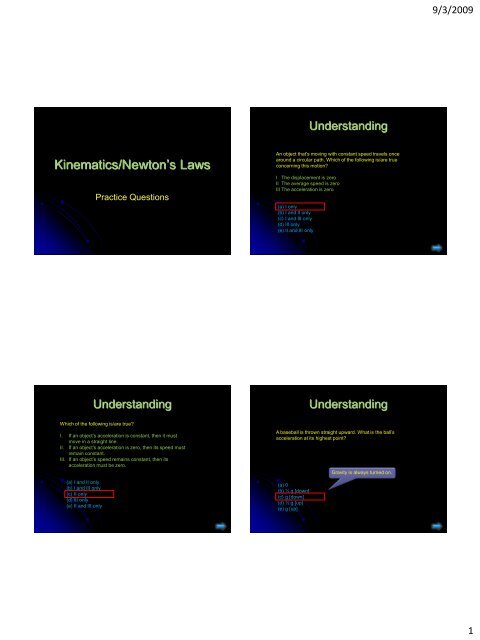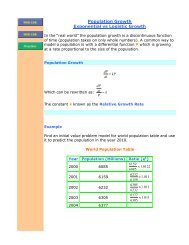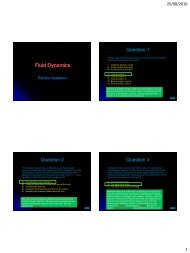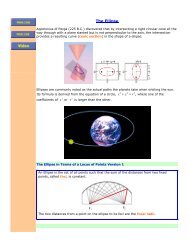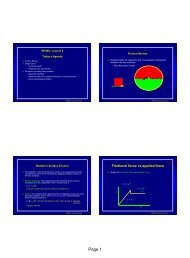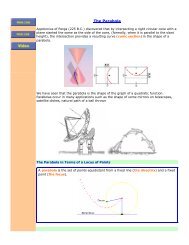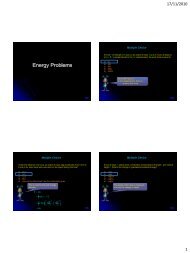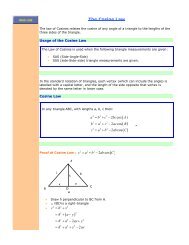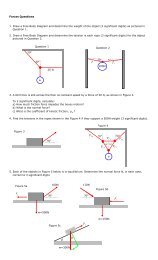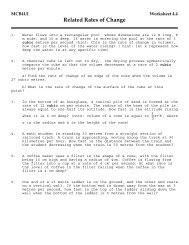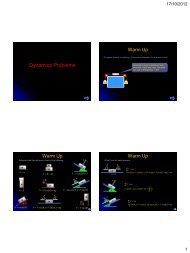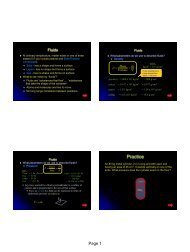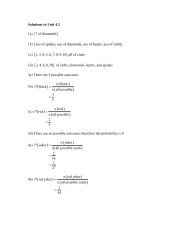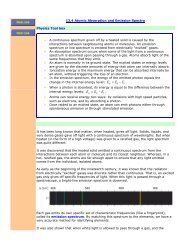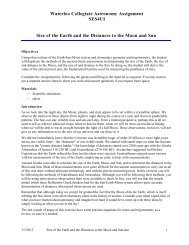Kinematics/Newton's Laws - The Burns Home Page
Kinematics/Newton's Laws - The Burns Home Page
Kinematics/Newton's Laws - The Burns Home Page
Create successful ePaper yourself
Turn your PDF publications into a flip-book with our unique Google optimized e-Paper software.
9/3/2009<br />
Understanding<br />
<strong>Kinematics</strong>/Newton’s <strong>Laws</strong><br />
Practice Questions<br />
An object that’s moving with constant speed travels once<br />
around a circular path. Which of the following is/are true<br />
concerning this motion?<br />
I <strong>The</strong> displacement is zero<br />
II <strong>The</strong> average speed is zero<br />
III <strong>The</strong> acceleration is zero<br />
(a) I only<br />
(b) I and II only<br />
(c) I and III only<br />
(d) III only<br />
(e) II and III only<br />
Understanding<br />
Understanding<br />
Which of the following is/are true?<br />
I. If an object’s acceleration is constant, then it must<br />
move in a straight line.<br />
II. If an object’s acceleration is zero, then its speed must<br />
remain constant.<br />
III. If an object’s speed remains constant, then its<br />
acceleration must be zero.<br />
(a) I and II only<br />
(b) I and III only<br />
(c) II only<br />
(d) III only<br />
(e) II and III only<br />
A baseball is thrown straight upward. What is the ball’s<br />
acceleration at its highest point?<br />
(a) 0<br />
(b) ½ g [down]<br />
(c) g [down]<br />
(d) ½ g [up]<br />
(e) g [up]<br />
Gravity is always turned on.<br />
1
9/3/2009<br />
Understanding<br />
Understanding<br />
Hint:<br />
How long would it take a car, starting from rest and<br />
accelerating uniformly in a straight line at 5 m/s 2 , to cover<br />
a distance of 200m?<br />
1<br />
s v0t at<br />
2<br />
(a) 9.0 s<br />
(b) 10.5 s<br />
(c) 12.0 s<br />
(d) 15.5 s<br />
(e) 20.0 s<br />
2<br />
m 1 m<br />
200m 0 t 5<br />
t<br />
2 <br />
s 2 s <br />
2 400m<br />
t <br />
m<br />
5<br />
2<br />
s<br />
t 8.9s<br />
2<br />
Hint:<br />
A rock is dropped off a cliff and strikes the ground with an<br />
impact of 30 m/s. How high was the cliff?<br />
We need both the<br />
initial and final velocity<br />
in the equation<br />
(a) 15.0 m<br />
(b) 20 m<br />
(c) 30 m<br />
(d) 46 m<br />
(e) 60 m<br />
v v 2a s<br />
2 2<br />
f i<br />
v v 2a s<br />
2 2<br />
f i<br />
<br />
v v<br />
s<br />
<br />
2a<br />
2 2<br />
f i<br />
<br />
<br />
<br />
2 2<br />
m m<br />
30 0<br />
<br />
s s<br />
<br />
<br />
m <br />
29.8<br />
2 <br />
s <br />
45.9m<br />
Understanding<br />
Understanding<br />
A stone is thrown horizontally with an initial speed of 10 m/s from a<br />
bridge. If air resistance could be ignored, how long would it take the<br />
stone to strike the water 80 m below the bridge?<br />
Hint:<br />
We need only think<br />
about the vertical<br />
components.<br />
(a) 1 s<br />
(b) 2 s<br />
(c) 4 s<br />
(d) 6 s<br />
(e) 8 s<br />
1<br />
s v0t at<br />
2<br />
m 1 m<br />
80m 0 t 9.8<br />
t<br />
2 <br />
s 2 s <br />
2 160m<br />
t <br />
m<br />
9.8<br />
2<br />
s<br />
t 4.0s<br />
2<br />
2<br />
A soccer ball, at rest on the ground, is kicked with an initial velocity of 10<br />
m/s at a launch angle of 30 0 . Calculate its total flight time, assuming air<br />
resistance is negligible?<br />
Hint:<br />
We need only think<br />
about the vertical time<br />
to travel up to its max<br />
height, then double it.<br />
(a) 0.5 s<br />
(b) 1 s<br />
(c) 1.7 s<br />
(d) 2 s<br />
(e) 4 s<br />
v v at<br />
f<br />
i<br />
vf<br />
vi<br />
t <br />
a<br />
m m <br />
0 10 sin 30<br />
s s<br />
<br />
<br />
m <br />
9.8<br />
2 <br />
s <br />
0.51s<br />
2
9/3/2009<br />
Understanding<br />
A stone is thrown horizontally with an initial speed of 30 m/s from a<br />
bridge. Find the stone’s total speed when it enters the water 4 seconds<br />
later?<br />
Hint:<br />
We need only think<br />
about the vertical time<br />
to travel to find vertical<br />
speed, then combine<br />
with horizontal speed<br />
(a) 30 m/ s<br />
(b) 40 m/s<br />
(c) 50 m/s<br />
(d) 60 m/s<br />
(e) 70 m/s<br />
v v at<br />
f<br />
i<br />
m m<br />
vyf<br />
0 9.8 2<br />
4s<br />
s s<br />
m<br />
39.2<br />
s<br />
v 2 2<br />
f<br />
vx vy<br />
m<br />
vxf<br />
30<br />
2 2<br />
s<br />
m m<br />
39.2 30<br />
2 2 <br />
s s <br />
m<br />
49.4<br />
2<br />
s<br />
Understanding<br />
Which of the following statements is true concerning the<br />
motion of an ideal projectile launched at an angle of 45 0<br />
to the horizontal?<br />
(a) <strong>The</strong> acceleration vector points opposite to the<br />
velocity vector on the way up and in the same<br />
direction as the velocity vector on the way down.<br />
(b) <strong>The</strong> speed at the top of the trajectory is zero.<br />
(c) <strong>The</strong> object’s total speed remains constant during the<br />
entire flight.<br />
(d) <strong>The</strong> horizontal speed decreases on the way down.<br />
(e) <strong>The</strong> vertical speed decreases on the way up and<br />
increases on the way down.<br />
Understanding<br />
This question concerns the motion of a car on a straight track; the car’s velocity<br />
as a function of time is plotted below<br />
20<br />
velocity (m/s)<br />
Understanding<br />
This question concerns the motion of a car on a straight track; the car’s velocity<br />
as a function of time is plotted below<br />
20<br />
velocity (m/s)<br />
10<br />
10<br />
time (s)<br />
1 2 3 4 5 6 7<br />
time (s)<br />
1 2 3 4 5 6 7<br />
−10<br />
−10<br />
−20<br />
(a) Describe what happened to the car at time t=1 s<br />
(b) How does the car’s average velocity between time t=0 sand t=1 s compare to its<br />
average velocity between times t=1 s and t=5 s?<br />
(c) What is the displacement of the car from time t=0 to time t=7s?<br />
(d) Plot the car’s acceleration during this interval as a function of time.<br />
(e) Plot the object’s position during this interval as a function of time. Assuming that<br />
the car begins at s=0.<br />
−20<br />
(a) Describe what happened to the car at time t=1 s<br />
<strong>The</strong> car’s velocity remains at 20 m/s, but the acceleration changes from<br />
positive to negative at this time (the foot leaves the accelerator)<br />
3
9/3/2009<br />
Understanding<br />
This question concerns the motion of a car on a straight track; the car’s velocity<br />
as a function of time is plotted below<br />
20<br />
velocity (m/s)<br />
Understanding<br />
This question concerns the motion of a car on a straight track; the car’s velocity<br />
as a function of time is plotted below<br />
20<br />
velocity (m/s)<br />
10<br />
10<br />
time (s)<br />
1 2 3 4 5 6 7<br />
time (s)<br />
1 2 3 4 5 6 7<br />
−10<br />
−10<br />
−20<br />
(b) How does the car’s average velocity between time t=0 sand t=1 s compare to its<br />
average velocity between times t=1 s and t=5 s?<br />
Between t=0 and t=1: the average velocity is ½(0 m/s + 20 m/s)=10 m/s<br />
Between t=1 and t=5: the average velocity is ½(20m/s + 0m/s)=10 m/s<br />
−20<br />
(c) What is the displacement of the car from time t=0 to time t=7s?<br />
Displacement is the net area between the graph as the time axis<br />
Area=1/2(5*20) – ½(2*10) =40m<br />
Understanding<br />
This question concerns the motion of a car on a straight track; the car’s velocity<br />
as a function of time is plotted below<br />
20<br />
velocity 20 velocity (m/s) (m/s)<br />
Understanding<br />
This question concerns the motion of a car on a straight track; the car’s velocity<br />
as a function of time is plotted below<br />
50<br />
velocity (m/s) 20 velocity (m/s)<br />
10<br />
10<br />
40<br />
10<br />
time (s)<br />
1 2 4 5 6 7<br />
3 time (s)<br />
1 2 3 4 5 6 7<br />
30<br />
time (s)<br />
1 2 3 4 5 6 7<br />
−10<br />
20<br />
−10<br />
−10<br />
−20<br />
10<br />
−20<br />
−20<br />
(d) Plot the car’s acceleration during this interval as a function of time.<br />
time (s)<br />
1 2 3 4 5 6 7<br />
(e) Plot the object’s position during this interval as a function of time. Assuming that<br />
the car begins at s=0.<br />
4
9/3/2009<br />
Understanding<br />
A cannonball is shot with an initial speed of 50 m/s at a launch angle of 40 0<br />
toward a castle wall 220m away. <strong>The</strong> height of the wall is 30 m. Assume that<br />
effects due to the air are negligible.<br />
(a) Show that the cannonball will strike the wall.<br />
(b) How long will it take for the cannonball to strike the wall?<br />
(c) At what height above the base of the wall will the cannonball strike?<br />
Understanding<br />
A cannonball is shot with an initial speed of 50 m/s at a launch angle of 40 0<br />
toward a castle wall 220m away. <strong>The</strong> height of the wall is 30 m. Assume that<br />
effects due to the air are negligible.<br />
(a) Show that the cannonball will strike the wall.<br />
1 2<br />
x v0<br />
xt<br />
y v0<br />
yt gt<br />
2<br />
x<br />
2<br />
t <br />
x 1 x <br />
v<br />
v0<br />
sin<br />
<br />
2<br />
0x<br />
g<br />
v0cos<br />
<br />
<br />
2 v0cos<br />
<br />
<br />
<br />
x<br />
2<br />
<br />
gx<br />
v cos x tan <br />
<br />
2 2<br />
0 <br />
<br />
2v0<br />
cos <br />
<br />
m <br />
2<br />
9.8 2 220m<br />
s<br />
220m tan 40<br />
<br />
<br />
2<br />
m 2<br />
250 cos 40<br />
s <br />
23m<br />
v 2<br />
sin 0 2 <br />
R <br />
g<br />
m <br />
50 sin 240<br />
s<br />
R <br />
<br />
m <br />
9.8<br />
2 <br />
s <br />
251m<br />
We need now only show that the<br />
height of the ball is below 30 m<br />
when the horizontal displacement<br />
is 220m<br />
This is less than 30 m, so contact<br />
Understanding<br />
A cannonball is shot with an initial speed of 50 m/s at a launch angle of 40 0<br />
toward a castle wall 220m away. <strong>The</strong> height of the wall is 30 m. Assume that<br />
effects due to the air are negligible.<br />
b) How long will it take for the cannonball to strike the wall?<br />
x<br />
t <br />
v<br />
0x<br />
x<br />
<br />
v cos 0<br />
<br />
<br />
220m<br />
m <br />
50 cos40<br />
s <br />
5.7s<br />
<br />
Understanding<br />
A cannonball is shot with an initial speed of 50 m/s at a launch angle of 40 0<br />
toward a castle wall 220m away. <strong>The</strong> height of the wall is 30 m. Assume that<br />
effects due to the air are negligible.<br />
c) At what height above the base of the wall will the cannonball strike?<br />
From (a) we have 23 m<br />
5
9/3/2009<br />
Understanding<br />
A physics student is driving home after class. <strong>The</strong> car is travelling at 14.7 m/s<br />
when it approaches an intersection. <strong>The</strong> student estimates that he is 20.0 m<br />
from the entrance to the intersection (10.0 m wide) when the traffic light changes<br />
from green to yellow. <strong>The</strong> light will change from yellow to red in 3.00 seconds.<br />
<strong>The</strong> maximum safe deceleration of the car is 4.00 m/s 2 while the maximum<br />
acceleration of the car is 2.00 m/s 2 . Should the physics student a) decelerate<br />
and stop or b) accelerate and travel through the intersection? Note: there is a<br />
police car directly behind the student.<br />
Understanding<br />
A physics student is driving home after class. <strong>The</strong> car is travelling at 14.7 m/s when it<br />
approaches an intersection. <strong>The</strong> student estimates that he is 20.0 m from the entrance to<br />
the intersection (10.0 m wide) when the traffic light changes from green to yellow. <strong>The</strong> light<br />
will change from yellow to red in 3.00 seconds. <strong>The</strong> maximum safe deceleration of the car<br />
is 4.00 m/s 2 while the maximum acceleration of the car is 2.00 m/s 2 . Should the physics<br />
student a) decelerate and stop or b) accelerate and travel through the intersection? Note:<br />
there is a police car directly behind the student.<br />
Let’s try braking first and see how far the car travels before stopping.<br />
Data Inventory<br />
m<br />
a 4.0<br />
2<br />
s<br />
x 0m<br />
i<br />
m<br />
vi<br />
14.7<br />
s<br />
m<br />
v<br />
f<br />
0<br />
s<br />
t 3.0 s<br />
x ?<br />
f<br />
1 2<br />
We shall use: x<br />
f<br />
xi vit at<br />
2<br />
m 1 m<br />
x<br />
f<br />
0m 14.7 3.0s 4 3.0s<br />
2 <br />
s 2 s <br />
0m 44.1m 18.0m<br />
26.1m<br />
2<br />
<strong>The</strong>refore the student will travel 6.1 m into the intersection<br />
(not good with police car behind him)<br />
Understanding<br />
A physics student is driving home after class. <strong>The</strong> car is travelling at 14.7 m/s when it<br />
approaches an intersection. <strong>The</strong> student estimates that he is 20.0 m from the entrance to<br />
the intersection (10.0 m wide) when the traffic light changes from green to yellow. <strong>The</strong> light<br />
will change from yellow to red in 3.00 seconds. <strong>The</strong> maximum safe deceleration of the car<br />
is 4.00 m/s 2 while the maximum acceleration of the car is 2.00 m/s 2 . Should the physics<br />
student a) decelerate and stop or b) accelerate and travel through the intersection? Note:<br />
there is a police car directly behind the student.<br />
Now let’s try accelerating and see how far the car travels before the light turns red.<br />
Data Inventory<br />
m<br />
a 2.0<br />
2<br />
s<br />
x 0m<br />
i<br />
m<br />
vi<br />
14.7<br />
s<br />
v ?<br />
f<br />
t 3.0 s<br />
x ?<br />
f<br />
1 2<br />
We shall use: x<br />
f<br />
xi vit at<br />
2<br />
m 1 m<br />
x<br />
f<br />
0m 14.7 3.0s<br />
2.0 3.0s<br />
2 <br />
s 2 s <br />
0m 44.1m 9.0m<br />
53.1m<br />
2<br />
<strong>The</strong>refore the student will travel about 23 m past the<br />
intersection before the light turns red.<br />
Understanding<br />
A car traveling at a constant speed of 30 m/s passes a highway patrol police car<br />
which is at rest. <strong>The</strong> police officer accelerates at a constant rate of 3.0 m/s 2 and<br />
maintains this rate of acceleration until he pulls next to the speeding car.<br />
Assume that the police car starts to move at the moment the speeder passes<br />
the car. Determine:<br />
a) <strong>The</strong> time required for the police officer to catch the speeder?<br />
b) <strong>The</strong> distance travelled during the chase?<br />
6
9/3/2009<br />
Understanding<br />
A car traveling at a constant speed of 30 m/s passes a highway patrol police car which is<br />
at rest. <strong>The</strong> police officer accelerates at a constant rate of 3.0 m/s 2 and maintains this rate<br />
of acceleration until he pulls next to the speeding car. Assume that the police car starts to<br />
move at the moment the speeder passes the car. Determine:<br />
a) <strong>The</strong> time required for the police officer to catch the speeder?<br />
Plan of attack: If we can find a position function for both the motorist and the<br />
police car in terms of time, then we can set both functions equal to each other<br />
(same position) and solve for time<br />
Data Inventory motorist<br />
m<br />
a 0<br />
2<br />
s<br />
x 0m<br />
i<br />
m<br />
vi<br />
30<br />
s<br />
m<br />
v<br />
f<br />
30<br />
s<br />
t ?<br />
x ?<br />
f<br />
x x vt<br />
f<br />
i<br />
m <br />
x<br />
f<br />
0m 30 t<br />
s <br />
m <br />
xf<br />
30 t<br />
s <br />
Data Inventory Police<br />
m<br />
a 3.0<br />
2<br />
s<br />
x 0m<br />
i<br />
m<br />
vi<br />
0<br />
s<br />
v ?<br />
f<br />
t ?<br />
x ?<br />
f<br />
1<br />
x<br />
f<br />
xi vit at<br />
2<br />
m 1 m<br />
x<br />
f<br />
0m 0 t 3.0<br />
t<br />
2 <br />
s 2 s <br />
m 2<br />
xf<br />
1.5 t<br />
2 <br />
s <br />
2<br />
2<br />
Let’s set then equal and solve<br />
m m<br />
2<br />
30 t<br />
1.5<br />
t<br />
2 <br />
s s <br />
m m<br />
0 30 t<br />
1.5 t<br />
s s <br />
2<br />
2 <br />
m m<br />
<br />
0 t<br />
30 1.5 t<br />
2 <br />
s s <br />
<br />
Understanding<br />
<strong>The</strong>refore the police car catches up with<br />
the speeder at 20s (the 0s is when the<br />
car initially passes the police car)<br />
<strong>The</strong>refore<br />
t 0<br />
or<br />
m m<br />
30 1.5 0<br />
2 t <br />
s s <br />
m m<br />
1.5 t 30<br />
2 <br />
s s<br />
m<br />
30<br />
t s<br />
m<br />
1.5<br />
2<br />
s<br />
20s<br />
Understanding<br />
Understanding<br />
A car traveling at a constant speed of 30 m/s passes a highway patrol police car which is<br />
at rest. <strong>The</strong> police officer accelerates at a constant rate of 3.0 m/s 2 and maintains this rate<br />
of acceleration until he pulls next to the speeding car. Assume that the police car starts to<br />
move at the moment the speeder passes the car. Determine:<br />
b) <strong>The</strong> distance travelled during the chase?<br />
A stone is thrown vertically upward from the edge of a building 19.6 m high with<br />
an initial velocity of 14.7 m/s. <strong>The</strong> stone just misses the building on the way<br />
down and strikes the street below. Determine:<br />
a) <strong>The</strong> time of flight?<br />
b) <strong>The</strong> velocity of the stone just before it strikes the ground ?<br />
Since we know the time (20s) from part a), we need only plug it into the<br />
distance formula from either car. [let’s use the speeder ]<br />
x<br />
f<br />
vt<br />
m <br />
30 20s<br />
s <br />
600m<br />
<br />
7
9/3/2009<br />
Understanding<br />
Understanding<br />
A stone is thrown vertically upward from the edge of a building 19.6 m high with<br />
an initial velocity of 14.7 m/s. <strong>The</strong> stone just misses the building on the way<br />
down and strikes the street below. Determine:<br />
a) <strong>The</strong> time of flight?<br />
Given:<br />
Required:<br />
m<br />
vi<br />
14.7<br />
s<br />
m<br />
a 9.80<br />
2<br />
s<br />
x 19.6m<br />
i<br />
x 0m<br />
f<br />
t<br />
Relationship:<br />
Work:<br />
1<br />
x<br />
f<br />
xi vit at<br />
2<br />
2<br />
1 2<br />
x<br />
f<br />
xi vit at<br />
2<br />
1<br />
0 <br />
2<br />
2<br />
at vit xi x<br />
f<br />
2 1<br />
<br />
vi vi 4<br />
a 2<br />
xi x<br />
f<br />
<br />
t <br />
1<br />
<br />
2<br />
a <br />
2 <br />
2<br />
v vi 2a xi x<br />
f<br />
<br />
a<br />
<br />
2<br />
m m m <br />
14.7 14.7 2 9.8 2 19.6m<br />
0m<br />
s s s <br />
<br />
m<br />
9.8<br />
2<br />
s<br />
<br />
<br />
<strong>The</strong>refore<br />
t 1s<br />
t 4s<br />
Flight time is 4 s<br />
A stone is thrown vertically upward from the edge of a building 19.6 m high with<br />
an initial velocity of 14.7 m/s. <strong>The</strong> stone just misses the building on the way<br />
down and strikes the street below. Determine:<br />
b) <strong>The</strong> velocity of the stone just before it strikes the ground ?<br />
m<br />
v 14.7<br />
Given: i<br />
<br />
s<br />
Work:<br />
m<br />
a 9.80<br />
2<br />
s<br />
v vi<br />
at<br />
f<br />
xi<br />
19.6m<br />
m m<br />
14.7 9.<br />
80 2 4.<br />
0s<br />
xf<br />
0m<br />
s s <br />
t 4s<br />
Required: v<br />
f<br />
Relationship:<br />
m<br />
245<br />
.<br />
s<br />
<strong>The</strong> negative value in the velocity indicates that<br />
the stone is travelling downward.<br />
v<br />
f<br />
vi<br />
at<br />
`<br />
8


